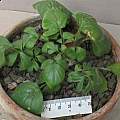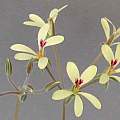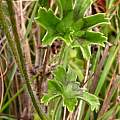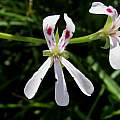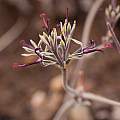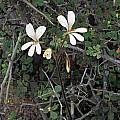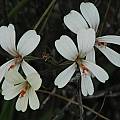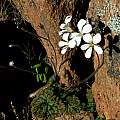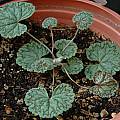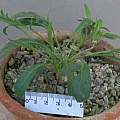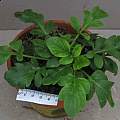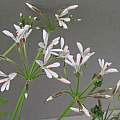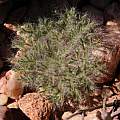Pelargonium species a-c are found on this wiki page
Pelargonium d-l - Pelargonium m-p - Pelargonium q-s - Pelargonium t-z - Pelargonium index
Pelargonium aciculatum E.M. Marais is a tuberous plant from the West Coast of South Africa (from Paleisheuwel to Riebeek-Kasteel) where it grows on foothills in renosterveld. The flowers are pale yellow or cream, with the upper two having red feathering. It flowers from November to December. The name refers to the very fine streaks of the feathering. (Section Hoarea, Aciculatum Group). The first photo of the foliage was taken by David Victor. The next two photos iNaturalist were taken by Gigi Laidler on the west coast in November and shared under a CC BY-NC license.
Pelargonium aestivale E.M. Marais is a tuberous species from the Great Karoo, in the summer rainfall area, from Carnarvon to Middelburg. It grows in karroid vegetation on rocky hillsides and on flat areas. Flowers may be cream or yellow, with the upper two tepals with wine red markings. It flowers from September to December. The name refers to the summer rainfall aspect. Comments as to whether the plant is correctly named would be welcomed by David Victor. (Section Hoarea, Fissifolium Group). Photos David Victor.
Pelargonium alchemilloides (L.) Aiton is a sprawling perennial with a tuberous rootstock that grows to 30 cm and resprouts after fire. It has lobed leaves usually with a dark zonal mark and white, yellow, or pink flowers, often marked with darker pink lines. This species occurs from the Cape Peninsula to Ethiopia and flowers in spring and summer. The first two photos below from the book Plants of the Klein Karoo courtesy of Jan and Anne Lise Schutte-Vlok. The last two photos were taken in the Eastern Cape by Cameron McMaster.
Pelargonium appendiculatum (L. f.) Willd. is a tuberous plant from the Leipoldtville area of South Africa (near Clanwilliam), where it grows on deep sandy soils. It has a short stem, covered with grey hairy leaves. The flowers are white or pale yellow. (ex Section Hoarea, now Section Ligularia). Photos 1-2 from David Victor. Photo 3 from Andrew Harvie.
Pelargonium asarifolium (Sweet) D. Don is a tuberous species from the Southwest Cape of South Africa, from Piketberg and Porterville, along the western coastal plain to Sir Lowry's Pass and Worcester. It grows on flats amongst small shrubs or on dry rocky slopes in sand or clay. It has two or sometimes three petals that are dark wine red in colour. Flowering is from November to May. The name refers to the similarity of the leaves to those of the genus Asarum. (Section Hoarea, Auritum Group). The first photo was taken by David Victor. The other photos from iNaturalist were taken in March in the Southwestern Cape by Carina Lochner and shared under a CC BY-NC license. She notes the plants were small, about 12 cm high. The last photo shows the leaves were dry at the base of the stem.
Pelargonium auritum Willd. is a South African tuberous species with two varieties.
Pelargonium auritum var. carneum (Harv.) E.M.Marais is distinguished from the type variety by its petal colour and by the absence of glandular hairs on the mericarps. Its native range is the Eastern Cape.
Pelargonium auritum var. auritum occurs from Clanwilliam to Addo and Port Elizabeth where it grows in a wide range of habitats. The flowers are dark purple-black. Flowering is from September to January. The name refers to the sometimes tripartite or auriculate leaves. (Section Hoarea, Auritum Group). The first photo of the leaves was taken by David Victor. The second and third photos by Andrew Wilson show flowers of different umbels under bright and partly clouded days. In Southern California the species blooms reliably, with multiple heads usually open in May and June.
Pelargonium barklyi Scott-Elliot is native to the Northwestern Cape of South Africa. It grows from a large tuber and produces large heart shaped leaves with purple zones during the winter months. The leaves are very hairy. These are followed by cream flowers held aloft on long petioles which appear at the end of the winter and in early spring. The first three photographs below were taken in Namaqualand in September 2006 by Bob Rutemoeller and Mary Sue Ittner. The leaves were protected below a shrub. And the flowers twined through the leaves and branches of the shrub. The last photo was also taken in Namaqualand by Cameron McMaster.
Photos below by Mary Sue Ittner show plants grown from seed. First the pot full of leaves emerging in winter, then a close-up of the flowers blooming in spring, seeds, and finally the tubers on a 1 cm grid.
Pelargonium bowkeri Harv. is a tuberous plant from a wide area of the summer rainfall area of Eastern South Africa. It has a short perennial stem and feathery leaves. The petals of the flowers are very fimbriate and coloured yellow and pink. (Section Polyactium). Photos David Victor
Pelargonium bubonifolium Pers. is a tuberous plant from the Northwestern Cape and Southern Namaqualand. It grows in semi-desert, stony places in clay. The flowers are white to pale pink and the upper two have red markings. Flowering is from August to October, making it one of the earliest in its section. The name refers to it having foliage similar to the genus Bubon, a synonym of Athamanta L., which are carrot like plants in the Apiaceae. (Section Hoarea, Auritum Group). The plant is illustrated in Pelargoniums of South Africa No. 3, on page 103, as P. namaquense. Photos were taken by David Victor.
Pelargonium caledonicum L. Bolus is a tuberous plant from a small area around Caledon in South Africa, growing in fynbos in shale. The foliage is hirsute and thus tinted grey. It has narrow white petals, with dark purple areas inset on all five petals. It flowers from December to January and its name comes from the area where it is found. (Section Hoarea, Proliferum Group). Photos David Victor.
Pelargonium campestre Harv. is a tuberous plant from the Cape Province of South Africa where it grows in grassy fields near the Zwartkops river, on shale. Its flowers are white and faintly veined and it flowers from October to December. The name refers to its habitat, meaning "of plains". (Section Hoarea, Incrassatum Group). Photos David Victor.
Pelargonium carneum Jacq. is a tuberous plant from the Southern Cape of South Africa, from Worcester and Villiersdorp to the Gamtoos river. Its flowers are white, pink, yellow, cream or flesh coloured with wine red markings on the upper two. It flowers from November to March. The name is derived from the flesh coloured form. (Section Hoarea, Incrassatum Group). The first two photos from David Victor. The last photo from the book Plants of the Klein Karoo courtesy of Jan and Anne Lise Schutte-Vlok.
Pelargonium caroli-henrici B. Nord. is a tuberous species from the west coast of South Africa, from the lowland quartzite areas of the Knersvlakte, from Garies to Koekenaap. It grows on flat areas on white quartzite with short succulent vegetation. Flowers are yellow or cream, the upper two having dark red claws and the other three having red blotches. Flowering is in October. The name honours a friend of the author of the species. (Section Hoarea, Caroli-Henrici Group). The photo from iNaturalist was taken by Nick Helme in Namaqualand in August and shared under a CC BY-SA license.
Pelargonium d-l - Pelargonium m-p - Pelargonium q-s - Pelargonium t-z - Pelargonium index



